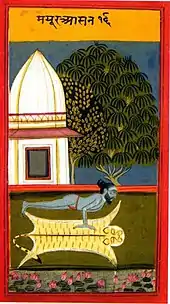Pasasana
Pasasana (Sanskrit: पाशासन; IAST: pāśāsana) or Noose Pose is an asana, a sitting meditation pose.

Pasasana
Etymology and origins
The name comes from the Sanskrit word पाश, pāśa meaning "noose" or "snare",[1] and आसन, asana meaning "posture" or "seat".[2]
The pose is described and illustrated in the 19th century Sritattvanidhi; a slightly different pose is described in the 1966 Light on Yoga.[3]
Description
In this yoga asana, the human body creates a 'noose' when the practitioner wraps their arms around their squatting legs (from Upaveshasana) with their hands clasped behind their back, while twisting to one side.[4]
See also
- List of asanas
- Pasini Mudra, the noose seal
References
- "Pashasana". Ashtanga Yoga. Archived from the original on 28 August 2012. Retrieved 27 January 2019.
- Sinha, S. C. (1996). Dictionary of Philosophy. Anmol Publications. p. 18. ISBN 978-81-7041-293-9.
- Sjoman, Norman E. (1999) [1996]. The Yoga Tradition of the Mysore Palace. Abhinav Publications. pp. 76, plate 8 (pose 47). ISBN 81-7017-389-2.
- Iyengar 1991, pp. 267–270.
Further reading
- Iyengar, B. K. S. (1991) [1966]. Light on Yoga. London: Thorsons. ISBN 978-0-00-714516-4. OCLC 51315708.
External links
Wikimedia Commons has media related to Pasasana.
This article is issued from Wikipedia. The text is licensed under Creative Commons - Attribution - Sharealike. Additional terms may apply for the media files.
_from_Jogapradipika_1830_(cropped).jpg.webp)

